At the Margins: The Art of Josephine Tota
Introduction
Today, there is an increasing call for change to the art historical framework; for dissolution of the insider/outsider duality and the integration and institutional sanctioning of art by outsiders. In this context, what are the challenges and opportunities implicit in rediscovering one of the so-called lost or dispossessed artists of art history?
Josephine Tota (1911–1996) was a seamstress and amateur artist who lived a conventional life among the Italian immigrant community in Rochester, NY. It was not until the end of her life that she made a discrete body of work, quietly producing wild, visionary tempera paintings over the course of a decade in the privacy of her home. For unconventional artists like Tota who insist upon pursuing their private visions, marginalization within an art historical framework is all too common.
In recent years, interest in traditionally marginalized art forms and makers has reached a fever pitch in the art world and in the media. Roberta Smith of the New York Times described the year 2013 as a “breakout moment for outsider art,” with an “increasing infiltration or dissolution of the mainstream.” 1 Critic Jerry Saltz, not the first to say it but perhaps the first to say it so emphatically, issued a clarion call to museums to stop segregating work by art world outsiders from the mainstream canon, to “Change—or wither with your prejudices and die a slow death.”2 Major exhibitions in recent years that feature this art on its own or alongside mainstream work include, the 2013 exhibition “Great and Mighty Things”: Outsider Art from the Jill and Sheldon Bonovitz Collection at the Philadelphia Museum of Art; the 2013 exhibition by Massimiliano Gioni, Encyclopedic Palace presented at the Venice Biennale; and the 2016 exhibition Unorthodox, held at the Jewish Museum. How might this paradigm shift toward boundary dissolution work to the advantage of Tota and artists like her? Conversely, how can artists, such as Tota, infiltrate the narrative landscape of American art to permanently alter it for the better?
The value of inviting the forgotten, the dispossessed—those ambiguous, indefinable artists such as Tota—into the conversation is their potential to complicate and expand the discourse. Museums, including the Memorial Art Gallery of the University of Rochester (MAG) where I serve as curator of American art, are seeking more inclusive ways to represent the history of art. Over the past five years at MAG, Tota’s relevance to the world beyond Rochester has been a subject of great consideration. Our attempts to categorize her work have helped articulate her marginalization and strengthen our belief in her value to the history of American art.
Several champions within the museum ultimately led to MAG acquiring fourteen of her paintings, with a traveling exhibition planned to begin in 2018. While Tota’s indefinable qualities make categorization challenging, the psychic urgency of her images has broad appeal. Her work has the potential to illuminate currents within the American experience that are primed for deeper art historical inquiry—the structural failure of the insider/outsider duality and the legacy of Surrealism, among others.
A Biographical Inquiry
For a previously undiscovered artist such as Josephine Tota, her life story provides an essential key to unlocking the personal iconography in her paintings. Despite the danger of viewing work made by artist outsiders solely through the lens of their biography, the circumstances of Josephine Tota’s life provide a basis for understanding her art.3 A thorough assessment of her oeuvre illustrates that Tota was an artist for whom her life, dreams, and memories were primary sources of inspiration. In her later years, she was interested in making art and little else, but she did not title or discuss her work, nor did she leave personal papers.4
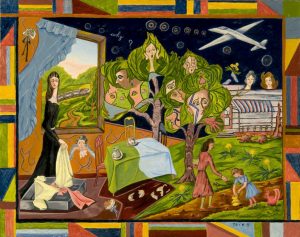
The only words from the artist on the subject of her art are, “When I am painting, I find peace . . . . My paintings are my inner soul.”5 Untitled (Life Story) is a complex, richly allegorical scene full of personal symbols, the meanings of which are largely unknown to us now (fig. 1).
Many of the motifs Tota employs are evident here: anxious women, ambiguous domestic spaces, masks, tears of blood, clothing, needles, and thread. Tota populated the scene with images and symbols of herself at different points in her life. Despite the appeal of her bright palette, multiple temporalities hopscotch around a shifting space in which no zone feels safe. The formal concerns of her work are unique to her: she was a lively and deliberate colorist, her compositions are complex yet balanced, and her applications of line, shape, and narrative simultaneously attract and repel viewers.
Born in Corato, Italy, in 1911, Tota recalled her childhood with fondness; she spent long hours absorbed by her imagination in communion with the natural world on her family farm. As a deeply sensitive child, who was unusually bright and outspoken, Tota often felt alienated from her four siblings and parents. Her feelings of isolation and marginalization were reinforced by the circumstances of her life, including early experiences of childhood poverty and the trauma of immigrating to the United States.
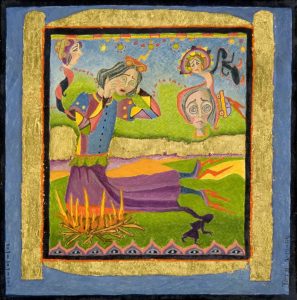
Tota was nine years old in 1920 when her family emigrated from Italy. Arriving in Rochester in upstate New York, the Tota family struggled with the harsh climate, debilitating poverty, and language barrier. During this period, Rochester attracted many skilled laborers and tailors from Italy who provided forty percent of the workforce for the booming clothing industry in the city.6 The Tota family—consisting of mother, father, four daughters, and one son—would have been subjected to the conflicting influences of the sizable Italian immigrant community and the Americanization of public schools and settlement houses in Rochester.7 Tota, on the cusp of puberty and her own developmental shift, had to navigate this wholly new cultural environment. Similar to other immigrant women who have struggled with the duality of their home and adopted cultures, Tota described having a fractured sense of self throughout her life.8 This sensation would take visible form in her paintings, more than sixty years later (fig. 2).
To contribute to the family income, Tota quit school in seventh grade to work as a seamstress. This would become her lifelong job, but she found it dull. She was a sensitive soul whose creativity gave her great joy, but she often had feelings of social alienation and depression. After marrying young, she suffered multiple traumatic miscarriages before giving birth to her only child, daughter Rosamond. The medical challenges and personal losses that Tota experienced throughout her life, of which there were many, resulted in deep emotional and physical scars.
In 1967, Tota’s life changed dramatically. The year brought a series of tragedies including the deaths of her mother and husband, her sister was diagnosed with cancer, and her own diagnosis of uterine cancer. She received radiation treatment that resulted in chronic neuropathic pain that she likened to having the lower half of her torso stuck with needles, or set on fire.9 This storm of personal tragedies led to her retirement and a depression so severe that she was hospitalized and subjected to shock therapy.
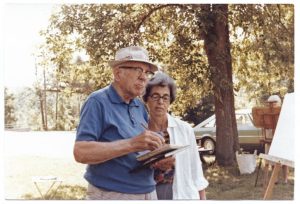
After her recovery and return home, Tota turned to art for solace. She was an avid amateur who took decades of painting classes, many of them at the community art school of the MAG, the Creative Workshop. Her painting instructors included Rochester artists, Carl W. Peters, who shared her spiritual connection with the natural landscape, and Fritz Trautmann, who shared her mystical relationship with color. It was under the tutelage of successful local artists that Tota explored her artistic impulses (fig. 3).
Tota was also a voracious visual consumer. While visiting her adult daughter in Manhattan, she would spend days gallery hopping in Soho, and hours enraptured by the medieval paintings at The Metropolitan Museum of Art. Tota’s natural inclination developed into a sophisticated and independent eye, honed by decades of seeing and making art.
Inspired by her love of medieval panel paintings, in her late sixties, Tota asked an artist friend to teach her how to paint in egg tempera. The tempera technique—grinding the pigments, mixing the paints, building up the image with multiple, small brushstrokes—provided a controlled environment in which to exorcise her fears. Now freed from the obligations of work, marriage, and motherhood, and newly introduced to a medium that complemented her creative temperament, Tota exercised artistic license. Her style shifted from traditional landscapes and still lifes, to intensely insular, surreal images with no precedent in her previous work. With the gilding, bright colors, elaborate compositions, and intense emotions, the influence of medieval painting is clear, but the content came entirely from Tota’s dreams and memories. As Michel Thévoz observed of outsider artists frequently hitting their stride in retirement age, sometimes “it takes seven decades to turn into an anarchist.”10
These paintings, over eighty in total, show the artist’s consistent preference for the particular scale and subject of small familial dramas. These unsettling female-led narratives take place at the sites of female bodies: bound, torn, in chains, at work, asleep, prostrate, weeping, and in pain. Her obsessive depictions revisit themes of metamorphosis, physical pain, human frailty, loss, and tragedy. There is the danger, violence, and disfigurement one might expect in illustrations of medieval martyrdoms or current day horror films, not from the brush of a reserved female septuagenarian (fig. 4).

After her introduction to tempera, Tota quit painting classes, preferring to work at home. Given the intensely personal nature of her two-dimensional work, it is not surprising that she chose not to continue to make her paintings in a classroom setting. Yet, having seen her work, Larry Merrill, director of the Creative Workshop, made frequent appeals to Tota to exhibit her paintings. Following a decade of focused, solitary painting at home, she reluctantly agreed to show her paintings at the school’s faculty and student exhibition space in January 1990. Tota was seventy-eight years old. A review in the local paper described how her imagery, despite years of training, had an “expressive, ‘primitive’ quality.”11 The small but well-received exhibition was the first and only time Tota’s late paintings were exhibited during her lifetime. Soon after, a diagnosis of progressive dementia eliminated the possibility of further exposure for her work.
The “Rediscovery”
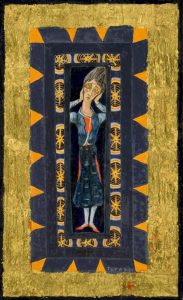
Shortly after the artist died in 1996, MAG acquired Untitled (Life Story) and a self-portrait from Tota’s daughter (fig. 5). Ten years later, I encountered these two paintings in museum art storage. After reestablishing contact with her descendants and featuring her paintings in a small, temporary installation, her daughter Rosamond offered to give MAG additional work by her mother. The museum’s encyclopedic collection holds more than 12,000 objects representing 5,000 years of world art. Tota’s singular vision and her historic connection to the institution, along with her unique perspective on the immigrant experience, led the museum to seize the opportunity for a greater depth of representation than would normally be sought for a little-known local artist. In 2011, the museum added twelve more Tota paintings to the collection, for a total of fourteen.12
The museum’s so-called rediscovery of Tota facilitated the integration of her work into MAG visitor experience. Two of her paintings are now on view in permanent collection galleries; her life story hangs near a Wendell Castle cabinet and across from a Roy De Forest painting and her self-portrait is one of the first works of art visitors see when they enter the museum. It is included in a salon-style hanging of more than twenty-five portraits that serve as an introduction to the collection, including a seventeenth-century Dutch portrait of a child, an Andy Warhol Jackie O. in blue, and a 2015 painting by Mickalene Thomas of her self-possessed muse Qusuquzah (fig. 6).
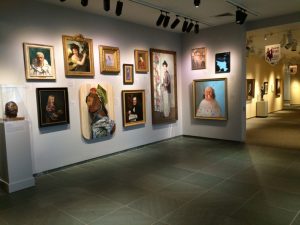
Tota’s paintings represent a unique strength of the MAG collection, since the museum is the only institution in which she is currently represented. The inclusion of her work in the permanent collection galleries gives visual force to the diverse histories of industry and immigration in Rochester. In a broader sense, her inclusion speaks to the complex and diverse narratives within the history of art represented in the museum collection. Tota’s contribution to the conversation is singular. Through her work, viewers bear witness to a creative impulse untethered to convention. Tota is one of the countless individuals, often unknown or unsung, who have followed their muse outside of art world expectations.
Art Historical Analysis
After locating Tota within the collection and galleries of the Memorial Art Gallery, the next challenge is to situate her within the national art historical framework. The contested category of outsider art is at the center of a complex and ongoing conversation within the discipline.13 New sub-categories are introduced and discarded in an effort to define the indefinable. Visionary, primitive, nonacademic, naive, Art Brut, and self-taught: yet none are fully satisfactory. The very qualities that comprise the category—individuality, singular vision, little or no artistic training—make a universally applicable title or definition impossible. Even the impulse to acknowledge and categorize this kind of art assumes a hegemonic framework. For current purpose, a reductive understanding and one that is continually being rewritten, identifies outsider artists as individuals often lacking in formal training who, with little thought to its reception, are compelled to make art.
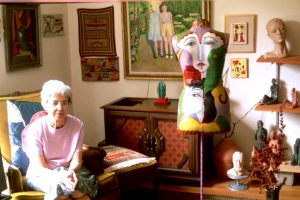
Tota’s creative impulse and obsessive imagery embody many of the defining characteristics of outsiders. Family members describe her intense compulsion to create and the transcendent states she experienced while consuming or producing art. Her patterning, framing, and horror vacui allowed her to impose order and control over painful memories. Photos of Josephine Tota in her home at the end of her life make clear that her primary audience was herself, as she sits surrounded by her paintings and her other artistic creations in clay and needlework (fig. 7). Her small apartment served as her studio and exhibition space. As Merrill wrote at the time of her exhibition, “frightening images of women gripped by doubt, fear and pain paradoxically calm her but spook the viewer.”14 Viewers of Tota’s paintings are interlopers in the private communications between the artist and herself.
Maurice Tuchman coined the term compulsive visionary to define artists whose work shows “A distinct compulsiveness, a visionary tone, a fusion of edgy uncertainty and anxiety with a firm certitude, a sense of exorcism, and the need and intent to get it out and place it down . . .”15 The uncanny tone, compulsion, and subject matter capture Tota’s feverish visions. Her expression served its purpose in the therapeutic and exorcising value of the creative process, not in its reception; a point further illustrated by her general disinterest in titling, discussing, or exhibiting her work.
Tota’s paintings are typical of an outsider or compulsive visionary in many ways. Yet, unlike most visionaries and outsiders, her artistic training was essential to her development. While her singular style and personal iconography developed mainly in the quiet isolation of her home, it grew out of decades of consuming and creating art within an art world infrastructure, however peripheral she may have been. These inspired, vivid depictions of her interior life were made possible because of her artistic training and awareness of art historical precedents, not in spite of them.
In some ways, Tota’s work has more in common with Surrealist artists, such as Leonora Carrington and Frida Kahlo, than it does with outsider or visionary artists. Earlier in the century, Carrington and Remedios Varo adopted Tota’s chosen medium of egg tempera. Beyond the desirability of the medium for its luminous, high-key tonalities, they appreciated the symbolic value of the egg and its potent associations with mysticism, reproduction, and domesticity.16 Like Carrington, Varo, and Kahlo, Tota’s paintings feature women as active agents. They play aggressor and victim, subject and object. Men and boys make only occasional appearances. The Surrealist language allowed these twentieth-century artists to explore the fraught relationship between their female identities and their female bodies.
Like her artistic ancestors, Tota’s work features dreamscapes, destabilized identities, and fairy tales, with incisive inquiries into womanhood and power.17 Domestic spaces, normally the domain of female power, are disrupted and threatened. Tota’s frequent doubling of figures within single compositions mirrors a similar fractured sense of self in the work of female Surrealists, which was associated with balancing a creative drive alongside marriage and motherhood.18
In her recent assessment of the qualities and influence of Surrealism in the United States, Sandra Zalman describes the “elastic” quality of American Surrealism and its relationship with American popular culture throughout the twentieth century.19 Indeed, two of Tota’s favorite artists, Kahlo and Salvador Dalí, had become pop culture figures and icons of the movement in America by Tota’s late phase in the 1980s. Further scholarship on Tota will contribute to the dialogue around the permissive spirit of the Surrealist idiom, its ability to fuel a new kind of personal exploration, and its ongoing influence upon the work of American women artists beyond the historic movement.
In conclusion, Tota’s images, produced in solitude more than fifty years after the golden age of Surrealism, present a point of view so fierce and uncompromising as to prove nearly inassimilable. Not wholly insider, outsider, or visionary, Tota’s work has refused to budge from its liminal space. In death as in life, she exists on the margins. The paradigm shift toward the institutional integration of art world outsiders has opened the door for her work to be known and appreciated by a wider audience.
Tota’s relevance was first extended beyond Rochester with the inclusion of my essay on the artist in Cynthia Fowler’s 2016 anthology, Locating American Art.20 The essays in that volume feature scholarly assessments of lesser-known works of art in museums outside of major cultural centers. Fowler makes the convincing argument that there is much to be uncovered in the far-flung corners of the nation, new artists and new narratives, to expand the scope and character of the discipline.
In her introduction, Fowler describes how the commitment made by the MAG to Josephine Tota’s artistic legacy serves as an example of regional museums providing “an important corrective to exclusionary studies of canonical artists.”21 By championing this overlooked, unconventional artist, MAG has expanded the American art ecosystem, to at least a small degree. To that end, the Memorial Art Gallery is in the midst of planning a 2018 exhibition, catalogue, and national tour that will further illuminate the work of this fascinating artist. Such endeavors as this can shine the light of inquiry on artists, such as Tota, which will result in a richer, more inclusive discipline that can encompass and more accurately reflect the vast field of American art.22
Acknowledgments
I would like to thank Bob Cozzolino for organizing the AHAA professional session in which I participated. And also thanks is due to Cynthia Fowler, editor of Locating American Art. This paper is adapted from my essay in that volume. Both Cozzolino and Fowler have inspired me to pursue paths of inquiry into the work of lesser-known artists.
DOI: https://doi.org/10.24926/24716839.1563
Notes
- Roberta Smith, “No More on the Outside Looking In,” New York Times, April 11, 2013. ↵
- Jerry Saltz, “Jerry Saltz on the Outsider Art Fair—and Why There’s No Such Thing as ‘Outsider’ Art,” Vulture, New York Magazine, February 1, 2013, accessed October 10, 2016, http://www.vulture.com/2013/02/jerry-saltz-on-the-outsider-art-fair.html?mid=imdb. ↵
- For an assessment of the complexities of biographical modes of inquiry for outsider artists in American art, see Lynne Cooke, “Orthodoxies Undermined,” in “Great and Mighty Things”: Outsider Art from the Jill and Sheldon Bonovitz Collection, ed. Ann Percy with Cara Zimmerman, exh. cat. (Philadelphia: Philadelphia Museum of Art; New Haven: Yale University Press, 2013), 204–14; and Catherine Morris, “Judith Scott and the Politics of Biography,” in Judith Scott: Bound & Unbound, eds. Catherine Morris and Matthew Higgs, exh. cat. (Brooklyn: Brooklyn Museum; New York: Prestel, 2014), 8–17. ↵
- I wish to thank the artist’s daughter, Rosamond Tota, and niece, Lisa Rosica, who have generously shared their rich understanding of Josephine Tota’s life and art with me: conversations between Rosica and the author, September 24, 2010, October 4, 2012, and October 5, 2013; emails from Rosica to the author, September 25, 2010, and July 23, 2014; emails from R. Tota to the author, November 21, 2010, and July 27, 2014; and conversation with Rosica and R. Tota and the author, October 5, 2013. ↵
- “Inside Out: Works by Josephine Tota and Julianna Furlong Williams,” Gallery Notes, 1990, Memorial Art Gallery archives. ↵
- Frank A. Salamone, Italians in Rochester, New York, 1900–1940 (Lewiston, NY: Edwin Mellen Press, 2000), 19. ↵
- Ibid., 59. ↵
- Rosica conversation with the author, October 4, 2012. For more on the duality experienced by immigrant women, see Roni Berger, Immigrant Women Tell Their Stories (New York: Routledge, 2011). ↵
- Rosica and R. Tota conversation with the author, October 5, 2013. ↵
- Michel Thévoz, “An Anti Museum: The Collection de l’Art Brut in Lausanne,” in The Artist Outsider: Creativity and the Boundaries of Culture, eds. Michael D. Hall and Eugene W. Metcalf, Jr., with Roger Cardinal (Washington and London: Smithsonian Institution Press, 1994), 62–75. ↵
- Ron Netsky, “Two Artists: Naïve by Design,” in the Democrat and Chronicle Arts section, February 11, 1990, 3D. Another notice of the exhibition, more descriptive than analytical, “Gallery Exhibit Showcases Works by Tota, Williams,” Brighton-Pittsford Post, February 1990, Memorial Art Gallery archives. ↵
- I would like to thank other champions at MAG of Tota’s work, which include Larry Merrill, Marjorie Searl, Grant Holcomb, Jonathan Binstock, and Marie Via. ↵
- While not feasible to include a full bibliography here, but see the seminal publications: Roger Cardinal, Outsider Art (New York: Praeger Publishers, 1972); Vera L. Zolberg and Joni Maya Cherbo, eds., Outsider Art: Contesting Boundaries in Contemporary Culture, (Cambridge: Cambridge University Press, 1997); Gary Allen Fine, Everyday Genius: Self-Taught Art and the Culture of Authenticity (Chicago: University of Chicago Press, 2004); and other relevant sources cited herein. ↵
- Inside Out, January 26–March 3, 1990, exh. pamphlet, Lucy Burne Gallery of the Creative Workshop, MAG archives. ↵
- Maurice Tuchman, introduction to Parallel Visions: Modern Artists and Outsider Art, Maurice Tuchman and Carol S. Eliel, eds., exh. cat. (Los Angeles: Los Angeles County Museum of Art, 1992), 10. ↵
- “The Alchemical Kitchen: Domestic Space as Sacred Space,” in Susan L. Aberth, Leonora Carrington: Surrealism, Alchemy and Art (London: Lund Humphries, 2004), 57–96. ↵
- For a recent and instructive text on the qualities of women Surrealists in the US and Mexico, see Ilene Susan Fort, Tere Arcq, and Terri Geis, eds., In Wonderland: The Surrealist Adventures of Women Artists in Mexico and the United States, exh. cat. (Los Angeles: Los Angeles County Museum of Art, 2012). ↵
- The sense of a fractured self and the need to represent it finds earlier examples in the work of female Surrealists, in particular Frida Kahlo, as Salomon Grimberg addressed in “Frida Kahlo: The Self as an End,” Mirror Images: Women, Surrealism, and Self-Representation, ed. Whitney Chadwick (Cambridge, The MIT Press, 1998), 83–104. ↵
- See Sandra Zalman, Consuming Surrealism in American Culture (Burlington, VT: Ashgate, 2015). ↵
- Jessica Marten, “At the Margins: The Art of Josephine Tota,” in Locating American Art: Finding Art’s Meaning in Museums, Colonial Period to the Present, ed. Cynthia Fowler, (Burlington, VT: Ashgate, 2016), 73–86. This article is adapted from my essay in Fowler’s anthology. I wish to thank her for her far-reaching vision, as well as her support and excellent editorial skill. ↵
- Fowler, Locating American Art, 5. ↵
- In the original paper presented at CAA, a possible exhibition pairing of Josephine Tota and Judith Schaechter was suggested. The Memorial Art Gallery is currently planning separate exhibitions for Tota (2018) and Schaechter (2020). The Tota exhibition and catalogue will include over eighty of the artist’s late paintings: fourteen from the collection of the Memorial Art Gallery and many paintings on loan from family and friends that have not been previously exhibited. ↵
About the Author(s): Jessica Marten is Curator in Charge/Curator of American Art at the Memorial Art Gallery of the University of Rochester.

